Subcellular localization of LGN during mitosis: evidence for its cortical localization in mitotic cell culture systems and its requirement for normal cell cycle progression
- PMID: 12925752
- PMCID: PMC181556
- DOI: 10.1091/mbc.e03-04-0212
Subcellular localization of LGN during mitosis: evidence for its cortical localization in mitotic cell culture systems and its requirement for normal cell cycle progression
Abstract
Mammalian LGN/AGS3 proteins and their Drosophila Pins orthologue are cytoplasmic regulators of G-protein signaling. In Drosophila, Pins localizes to the lateral cortex of polarized epithelial cells and to the apical cortex of neuroblasts where it plays important roles in their asymmetric division. Using overexpression studies in different cell line systems, we demonstrate here that, like Drosophila Pins, LGN can exhibit enriched localization at the cell cortex, depending on the cell cycle and the culture system used. We find that in WISH, PC12, and NRK but not COS cells, LGN is largely directed to the cell cortex during mitosis. Overexpression of truncated protein domains further identified the Galpha-binding C-terminal portion of LGN as a sufficient domain for cortical localization in cell culture. In mitotic COS cells that normally do not exhibit cortical LGN localization, LGN is redirected to the cell cortex upon overexpression of Galpha subunits of heterotrimeric G-proteins. The results also show that the cortical localization of LGN is dependent on microfilaments and that interfering with LGN function in cultured cell lines causes early disruption to cell cycle progression.
Figures
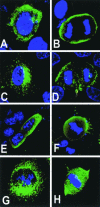
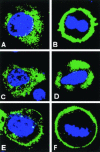
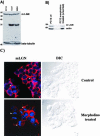
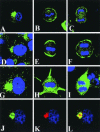




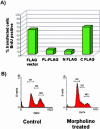
Similar articles
-
Asymmetric localization of LGN but not AGS3, two homologs of Drosophila pins, in dividing human neural progenitor cells.J Neurosci Res. 2004 Mar 15;75(6):782-93. doi: 10.1002/jnr.10874. J Neurosci Res. 2004. PMID: 14994339
-
Mammalian Pins is a conformational switch that links NuMA to heterotrimeric G proteins.Cell. 2004 Nov 12;119(4):503-16. doi: 10.1016/j.cell.2004.10.028. Cell. 2004. PMID: 15537540
-
Intramolecular interaction in LGN, an adaptor protein that regulates mitotic spindle orientation.J Biol Chem. 2019 Dec 20;294(51):19655-19666. doi: 10.1074/jbc.RA119.011457. Epub 2019 Nov 15. J Biol Chem. 2019. PMID: 31732560 Free PMC article.
-
Expression analysis and subcellular distribution of the two G-protein regulators AGS3 and LGN indicate distinct functionality. Localization of LGN to the midbody during cytokinesis.J Biol Chem. 2002 May 3;277(18):15897-903. doi: 10.1074/jbc.M112185200. Epub 2002 Feb 6. J Biol Chem. 2002. PMID: 11832491
-
LGN blocks the ability of NuMA to bind and stabilize microtubules. A mechanism for mitotic spindle assembly regulation.Curr Biol. 2002 Nov 19;12(22):1928-33. doi: 10.1016/s0960-9822(02)01298-8. Curr Biol. 2002. PMID: 12445386
Cited by
-
LGN regulates mitotic spindle orientation during epithelial morphogenesis.J Cell Biol. 2010 Apr 19;189(2):275-88. doi: 10.1083/jcb.200910021. Epub 2010 Apr 12. J Cell Biol. 2010. PMID: 20385777 Free PMC article.
-
Mechanistic pathways and biological roles for receptor-independent activators of G-protein signaling.Pharmacol Ther. 2007 Mar;113(3):488-506. doi: 10.1016/j.pharmthera.2006.11.001. Epub 2006 Nov 28. Pharmacol Ther. 2007. PMID: 17240454 Free PMC article. Review.
-
Epithelial polarity and spindle orientation: intersecting pathways.Philos Trans R Soc Lond B Biol Sci. 2013 Sep 23;368(1629):20130291. doi: 10.1098/rstb.2013.0291. Print 2013. Philos Trans R Soc Lond B Biol Sci. 2013. PMID: 24062590 Free PMC article. Review.
-
LGN loss randomizes spindle orientation and accelerates tumorigenesis in PTEN-deficient epidermis.Mol Biol Cell. 2024 Feb 1;35(2):br5. doi: 10.1091/mbc.E23-03-0111. Epub 2023 Nov 22. Mol Biol Cell. 2024. PMID: 37991903 Free PMC article.
-
Crystal structures of the scaffolding protein LGN reveal the general mechanism by which GoLoco binding motifs inhibit the release of GDP from Gαi.J Biol Chem. 2012 Oct 26;287(44):36766-76. doi: 10.1074/jbc.M112.391607. Epub 2012 Sep 5. J Biol Chem. 2012. PMID: 22952234 Free PMC article.
References
-
- Bernard, M.L., Peterson, Y.K., Chung, P., Jourdan, J., and Lanier, S.M. (2001). Selective interaction of AGS3 with G-proteins and the influence of AGS3 on the activation state of G-proteins. J. Biol. Chem. 276, 1585–1593. - PubMed
-
- Blatch, G.L., and Lassle, M. (1999). The tetratricopeptide repeat: a structural motif mediating protein-protein interactions. Bioessays 21, 932–939. - PubMed
-
- Blumer, J.B., Chandler, L.J., and Lanier, S.M. (2002). Expression analysis and subcellular distribution of the two G-protein regulators AGS3 and LGN indicate distinct functionality. Localization of LGN to the midbody during cytokinesis. J. Biol. Chem. 277, 15897–15903. - PubMed
-
- Chen, C., Zheng, B., Han, J., and Lin, S.C. (1997). Characterization of novel RGS proteins that bind to Gα proteins and inhibits pheromone signalling in yeast. J. Biol. Chem. 272, 8679–8685. - PubMed
MeSH terms
Substances
LinkOut - more resources
Full Text Sources
Molecular Biology Databases

